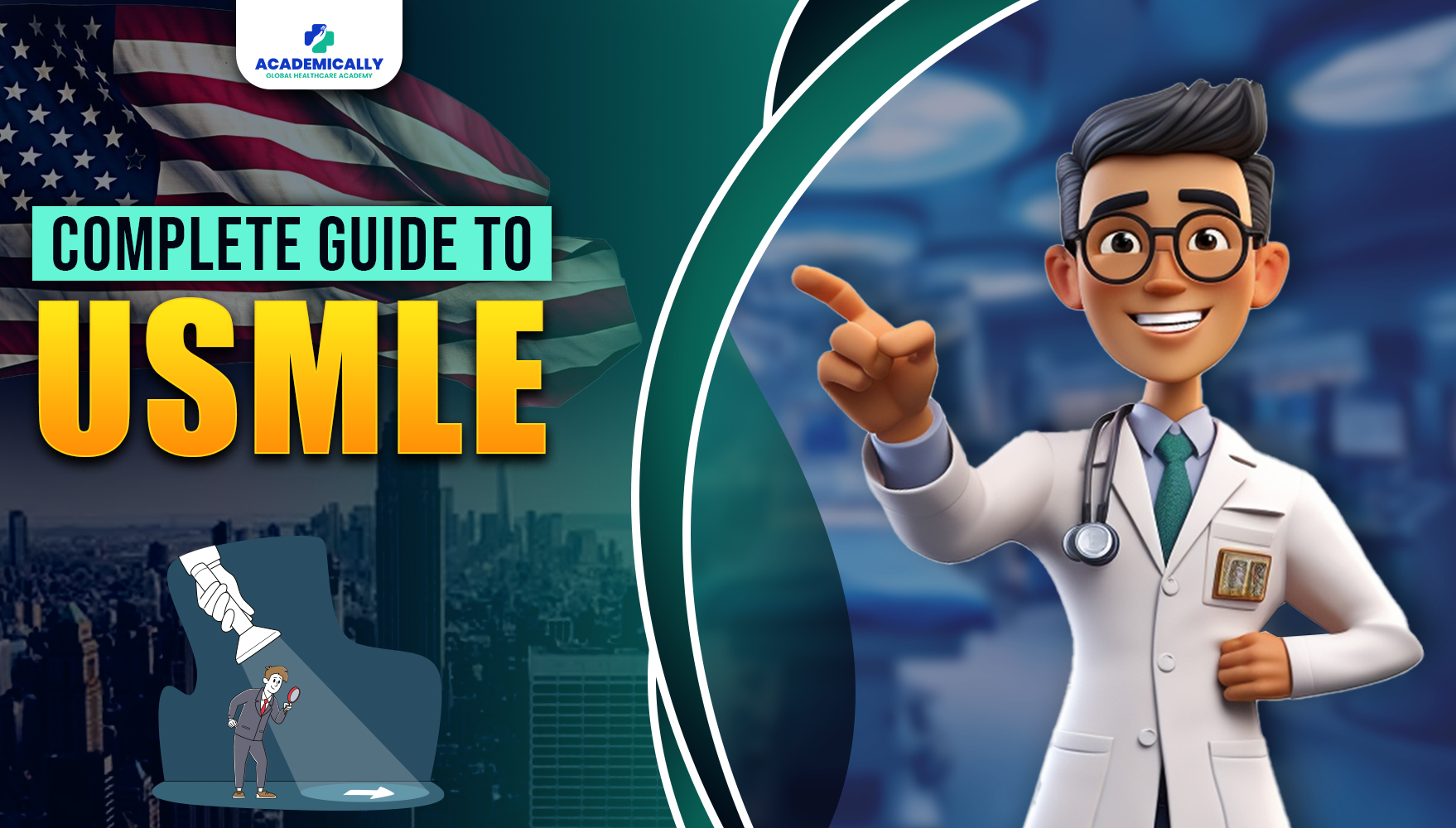Did you know over 24,000 international medical graduates appear for the USMLE every year all chasing the same dream? Practising medicine in the U.S. isn’t just about prestige it’s about access to some of the world’s best clinical training, global recognition, and an unmatched healthcare ecosystem. But to get there, one exam stands between you and that white coat in America: the USMLE.
Whether you’re a medical student planning ahead or a graduate ready to apply, knowing the USMLE exam syllabus and pattern isn’t optional, it’s essential. This blog breaks down Step 1, Step 2 CK, and Step 3 of the USMLE exam. Let’s dive in.
What is the USMLE?
The USMLE is a licensure exam for doctors. It is a three-step examination for medical licensure in the U.S. It’s made to assess whether a doctor can apply knowledge, concepts, and patient-centered skills in real-world clinical settings.
The three steps of USMLE are:
- Step 1 – Tests your basic medical science knowledge.
- Step 2 CK – Focuses on clinical knowledge and decision-making.
- Step 3 – Assesses your ability to practice medicine independently.
Each step is different — in structure, content, and purpose.
USMLE Step 1: Syllabus, Pattern & Structure
What is Step 1 all about?
Step 1 is the foundation of your USMLE journey. It evaluates your grasp of the basic scientific knowledge that is the foundation of clinical practice, the kind of knowledge you’ll be expected to apply every single day as a doctor.
If you're wondering what exactly is tested, here's a closer look.
USMLE Step 1 – Test Content Specifications
| System | Range (%) |
| Human Development | 1–3 |
| Blood & Lymphoreticular / Immune Systems | 9–13 |
| Behavioral Health & Nervous Systems / Special Senses | 10–14 |
| Musculoskeletal, Skin & Subcutaneous Tissue | 8–12 |
| Cardiovascular System | 7–11 |
| Respiratory & Renal / Urinary Systems | 11–15 |
| Gastrointestinal System | 6–10 |
| Reproductive & Endocrine Systems | 12–16 |
| Multisystem Processes & Disorders | 8–12 |
| Biostatistics & Epidemiology / Population Health | 4–6 |
| Social Sciences: Communication and Interpersonal Skills | 6–9 |
USMLE Step 1 – Physician Tasks / Competency Specifications
| Competency | Range (%) |
| Medical Knowledge: Applying Foundational Science Concepts | 60–70 |
| Patient Care: Diagnosis | 20–25 |
| History/Physical Examination | - |
| Diagnosis | - |
| Communication and Interpersonal Skills | 6–9 |
| Practice–Based Learning & Improvement | 4–6 |
USMLE Step 1 – Discipline Specifications
| Discipline | Range (%) |
| Pathology | 45–55 |
| Physiology | 30–40 |
| Pharmacology | 10–20 |
| Biochemistry & Nutrition | 5–15 |
| Microbiology | 10–20 |
| Immunology | 5–15 |
| Gross Anatomy & Embryology | 10–20 |
| Histology & Cell Biology | 5–15 |
| Behavioral Sciences | 10–15 |
| Genetics | 5–10 |
Step 1 Exam Pattern
- Exam Duration: 8 hours
- Format: Computer-based, MCQs
- Number of Questions: Around 280 MCQs
- Sections: Divided into 7 blocks, each lasting 60 minutes
- Break Time: 45 minutes (flexible)
We know that preparation for USMLE alone can be tough, but you don’t have to do it solo. Get access to AI-powered mock tests, clinical concept videos, and personalised study tracking all through Academically’s USMLE Preparation Program.
USMLE Step 2 CK: Syllabus, Pattern & Strategy
Step 2 CK (Clinical Knowledge) is designed to evaluate how well you can apply medical knowledge in direct patient care scenarios across hospitals, clinics, and emergency settings.
USMLE Step 2 CK – Test Content by System
| System | Range (%) |
| Human Development | 2–4 |
| Immune System | 3–5 |
| Blood & Lymphoreticular System | 3–6 |
| Behavioral Health | 5–10 |
| Nervous System & Special Senses | 5–10 |
| Musculoskeletal System / Skin & Subcutaneous Tissue | 6–12 |
| Cardiovascular System | 6–12 |
| Respiratory System | 5–10 |
| Gastrointestinal System | 5–10 |
| Renal & Urinary System & Reproductive Systems | 7–13 |
| Pregnancy, Childbirth & the Puerperium | 3–7 |
| Endocrine System | 3–7 |
| Multisystem Processes & Disorders | 4–8 |
| Biostatistics, Epidemiology & Interpretation of Literature | 3–5 |
| Social Sciences: Legal, Ethics, Professionalism, Patient Safety | 10–15 |
USMLE Step 2 CK – Physician Tasks / Competency Specifications
| Competency | Range (%) |
| Medical Knowledge: Applying Foundational Concepts | 0 |
| Patient Care: History and Physical Exam | 0 |
| Patient Care: Laboratory / Diagnostic Studies | 13–17 |
| Patient Care: Diagnosis | 16–20 |
| Patient Care: Prognosis / Outcome | 5–9 |
| Patient Care: Health Maintenance / Disease Prevention | 5–10 |
| Patient Care: Pharmacotherapy | 8–12 |
| Patient Care: Clinical Interventions | 6–10 |
| Patient Care: Mixed Management | 12–16 |
| Practice-Based Learning & Improvement | 3–5 |
| Professionalism | 5–7 |
| Systems-Based Practice & Patient Safety | 5–7 |
USMLE Step 2 CK – Discipline Specifications
| Discipline | Range (%) |
| Medicine | 55–65 |
| Surgery | 20–30 |
| Pediatrics | 17–27 |
| Obstetrics & Gynecology | 10–20 |
| Psychiatry | 10–15 |
Step 2 Exam Pattern
- Exam Duration: 9 hours
- Format: Computer-based MCQs, sequential case questions
- Number of Questions: Around 318
- Break: Minimum 45 minutes of break time during the exam.
USMLE Step 3: Syllabus, Pattern & Clinical Reasoning
Why Step 3 is Different and Crucial
Step 3 is the final stage of the USMLE series — and it’s the only one that tests whether you can practice independently. It’s about decision-making, efficiency, and real-time clinical judgment.
This is the exam that proves you're ready to take full responsibility for patient care.
Step 3 Content Specifications - MCQs
| System | Range (%) |
| Human Development | 1–3 |
| Immune System, Blood & Lymphoreticular System, and Multisystem Processes/Disorders | 6–8 |
| Behavioral Health | 4–6 |
| Nervous System & Special Senses | 8–10 |
| Skin & Subcutaneous Tissue | 4–6 |
| Musculoskeletal System | 5–7 |
| Cardiovascular System | 9–11 |
| Respiratory System | 8–10 |
| Gastrointestinal System | 6–8 |
| Renal / Urinary & Male Reproductive Systems | 4–6 |
| Pregnancy / Childbirth & Female Reproductive System & Breast | 7–9 |
| Endocrine System | 5–7 |
| Biostatistics, Epidemiology, Population Health & Interpretation of Literature | 11–13 |
| Social Sciences: Communication Skills, Ethics, & Patient Safety | 7–9 |
Step 3 Content Specifications - CCS
| Category | Covered |
| General Principles of Foundational Science | |
| Immune System | Yes |
| Blood & Lymphoreticular System | Yes |
| Behavioral Health | Yes |
| Nervous System & Special Senses | Yes |
| Skin & Subcutaneous Tissue | Yes |
| Musculoskeletal System | Yes |
| Cardiovascular System | Yes |
| Respiratory System | Yes |
| Gastrointestinal System | Yes |
| Renal & Urinary System | Yes |
| Pregnancy, Childbirth, & the Puerperium | Yes |
| Female Reproductive System & Breast | Yes |
| Male Reproductive System | Yes |
| Endocrine System | Yes |
| Multisystem Processes & Disorders | Yes |
| Biostatistics, Epidemiology, Population Health & Interpretation of Literature | |
| Social Sciences |
USMLE Step 3 – Day 1 MCQs
| Competency | Range (%) | Covered |
| Medical Knowledge: Applying Foundational Concepts | 11–12 | Yes |
| Patient Care: Diagnosis | 33–36 | Yes |
| History / Physical Exam | 5–9 | Yes |
| Laboratory / Diagnostic Studies | 9–12 | Yes |
| Diagnosis | 6–10 | Yes |
| Prognosis / Outcome | 8–11 | |
| Patient Care: Management | 32–35 | |
| Health Maintenance / Disease Prevention | 6–11 | |
| Pharmacotherapy | 9–13 | |
| Clinical Interventions | 5–9 | |
| Mixed Management | 6–11 | |
| Practice-based Learning & Improvement | 11–13 | Yes |
| Communication / Professionalism / Systems-based Practice & Patient Safety | 7–9 | Yes |
USMLE Step 3 – Day 2 MCQs
| Competency | Range (%) | Covered |
| Medical Knowledge: Applying Foundational Concepts | 11–12 | |
| Patient Care: Diagnosis | 33–36 | Yes |
| History / Physical Exam | 5–9 | |
| Laboratory / Diagnostic Studies | 9–12 | |
| Diagnosis | 6–10 | |
| Prognosis / Outcome | 8–11 | Yes |
| Patient Care: Management | 32–35 | Yes |
| Health Maintenance / Disease Prevention | 6–11 | Yes |
| Pharmacotherapy | 9–13 | Yes |
| Clinical Interventions | 5–9 | Yes |
| Mixed Management | 6–11 | Yes |
| Practice-based Learning & Improvement | 11–13 | |
| Communication and Professionalism | 7–9 |
USMLE Step 3 – Day 2 CCS
| Competency | Covered |
| Medical Knowledge / Scientific Concepts | |
| Patient Care: Diagnosis | Yes |
| History / Physical Exam | Yes |
| Laboratory / Diagnostic Studies | Yes |
| Diagnosis | Yes |
| Prognosis / Outcome | Yes |
| Patient Care: Management | Yes |
| Health Maintenance / Disease Prevention | Yes |
| Pharmacotherapy | Yes |
| Clinical Interventions | Yes |
| Mixed Management | Yes |
| Surveillance for Disease Recurrence | Yes |
| Communication and Professionalism | |
| Systems-based Practice / Patient Safety & Practice-based Learning |
Exam Duration:
Day 1: 7 hours
Day 2: 9 hours
Format:
Day 1: Computer-based MCQs
Day 2: MCQs + 13 interactive CCS (Computer-based Case Simulations)
Number of Questions:
Around 232 MCQs on Day 1
Around 180 MCQs + 13 CCS cases on Day 2
Breaks:
Minimum 45–60 minutes of break time
What is CCS? (Computer-based Case Simulations)
This is the part that feels most like real medicine. You’ll be given simulated cases, a digital patient, a time bar, and a list of orders. You’ll decide:
- What labs to order
- Whether to admit or discharge
- Which meds to start
- When to consult specialists
Each move impacts how the patient recovers — just like in real life.
CCS isn’t about memorizing protocols. It’s about thinking like a resident under time pressure.
The USMLE isn’t just a set of exams; it’s a filter that separates those who know medicine from those who can practice it. And now that you understand the full syllabus and pattern for all three steps, the path ahead is clearer.





